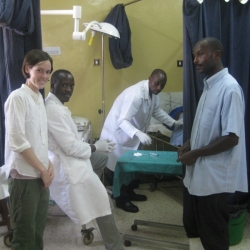Lori Ann Stolz, MD, was recently published in The Lancet, the world’s leading general medical journal. Her case report addresses the benefits of task shifting and the use of point-of-care ultrasound in resource-limited settings including acute care settings. The case report highlights its low cost, portability, safety and ease of use.
Dr. Stolz shares the success of small changes in the delivery of emergency care, known as  task shifting, in resource-limited settings that have resulted in impressive and tangible decreases in pediatric inpatient mortality. Task shifting has been used with success in other instances, including antiretroviral treatment and obstetrics care, but has not been readily adapted for acute care.
task shifting, in resource-limited settings that have resulted in impressive and tangible decreases in pediatric inpatient mortality. Task shifting has been used with success in other instances, including antiretroviral treatment and obstetrics care, but has not been readily adapted for acute care.
The DEM works with the Global Emergency Care Collaborative in rural Uganda to train nurses in the development of a basic differential diagnosis, the use and interpretation of bedside ultrasound, basic laboratory investigations, the provision of stabilizing treatment such as antibiotics and IV fluids and basic emergency procedures. In the emergency department of Karoli Lwanga Hospital, nurses are trained to assess which patients require emergency assessment by a physician and through its novel task-shifting program, nurses are trained to provide acute care when physicians are unavailable.
Emergent conditions that could be addressed by timely, accurate emergency care account for roughly 45 percent of all deaths and 35 percent of the disease burden in low-income and medium-income countries. Within the developed world, case fatality from intussusception is less than one percent; however, within sub-Saharan Africa, this number reaches 13 percent. Scarcity of diagnostic testing and delays in diagnosis are reasons for this disparity. Intussusception is only one of the conditions with high morbidity and mortality requiring advanced skills of recognition and prompt triage.
 In the case study, Dr. Stolz and colleagues Hilary Kizza, Kevin Little, and Joseph Kasekende share the successful treatment of a vomiting and weak five-month-old male baby who was brought to the emergency department of the Karoli Lwanga Hospital in rural Uganda. The child had been treated for malaria at an outside clinic for several days. Despite treatment, his malaise and vomiting had progressed, with new symptoms of abdominal distension and one episode of bloody stool.
In the case study, Dr. Stolz and colleagues Hilary Kizza, Kevin Little, and Joseph Kasekende share the successful treatment of a vomiting and weak five-month-old male baby who was brought to the emergency department of the Karoli Lwanga Hospital in rural Uganda. The child had been treated for malaria at an outside clinic for several days. Despite treatment, his malaise and vomiting had progressed, with new symptoms of abdominal distension and one episode of bloody stool.
On arrival at the emergency department, the child was assessed by local emergency care practitioners, who are nurses with two years of additional training in providing acute care without direct physician oversight. The emergency care practitioner identified the child as being acutely ill and needing resuscitation. The practitioners found striking abdominal swelling and noted tachypnoea and tachycardia and began initial stabilization with oxygen therapy and IV fluids.
The differential diagnosis consisted of small bowel obstruction, dysentery, typhoid fever, intussusception, intestinal obstruction, or peritonitis. The child had normal hemoglobin, negative rapid HIV test and blood smear without parasites.
The radiology department, which could provide plain radiography and ultrasound only during daytime hours, was closed. The nurse was able to perform point-of-care abdominal ultrasound using a SonoSite MicroMaxx (Bothell, WA, USA). He saw trace free fluid in the abdomen, intestinal obstruction and a target sign (figure), which was confirmed by the attending physician.
Abdominal surgery showed that 13 cm of viable ileum had invaginated through the ileocaecal junction. The bowel was easily reduced and ileal resection was not necessary. The patient was treated postoperatively with analgesia and prophylactic antibiotics. He was discharged in good condition to home in the care of his mother five days after the operation. This case draws attention to a non-physician medical provider recognizing an emergent condition and expediting definitive treatment, and the effective use of task shifting.

